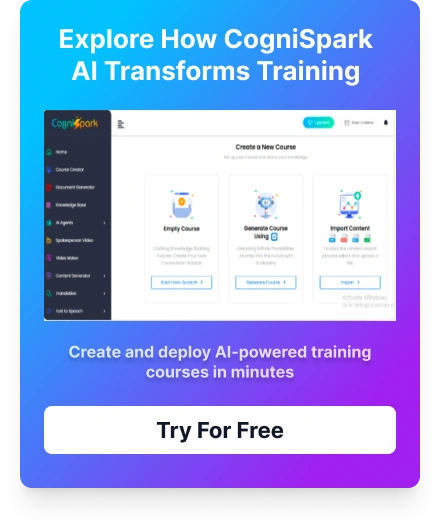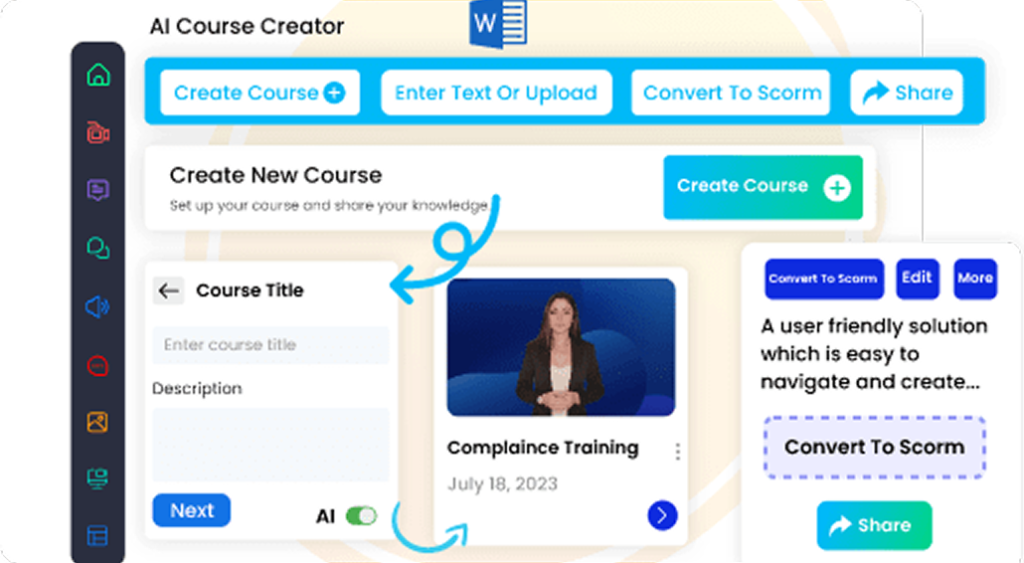The future of eLearning is here, and it’s powered by artificial intelligence (AI). As the global workforce continues to adapt to new learning environments, AI is revolutionizing how courses are designed, delivered, and experienced. With eLearning becoming an integral part of corporate training, academic settings, and personal development, understanding how AI is shaping this landscape is crucial for educational professionals, trainers, and organizations.
In this blog, we’ll explore how AI is automating the course design and delivery process, offering personalized experiences, streamlining content creation, and enhancing learner engagement. Whether you’re an instructional designer, corporate trainer, or course creator, this insight into AI course creation will give you a glimpse into the future of eLearning.
What Is AI’s Role in eLearning Course Design?
In the traditional approach to course design, instructional designers and trainers invest a significant amount of time and resources in creating content. This process involves researching, creating learning modules, designing assessments, and adapting materials based on learner feedback. However, AI is transforming this method by automating various aspects of course creation and reducing the time it takes to build effective learning experiences.
AI tools can now handle a variety of tasks involved in the course design process, including:
- Content Generation: AI can generate course materials based on input data such as subject matter, target audience, and learning objectives. By analyzing vast amounts of data, AI can create content that aligns with industry trends and learner preferences.
- Personalization: One of the standout benefits of AI course creation is its ability to deliver personalized learning paths. AI algorithms track learner progress and tailor content recommendations based on individual needs, improving engagement and outcomes.
- Automated Assessments: AI systems can create quizzes and assignments that adjust in difficulty based on a learner’s previous answers. This ensures that learners are consistently challenged while receiving timely feedback on their performance
By automating these tasks, AI allows course designers to focus on higher-level aspects such as strategy and pedagogy, increasing productivity and effectiveness.
How Does AI Improve the Delivery of eLearning Courses?
- Adaptive Learning: AI systems monitor learner behavior and dynamically adjust content to suit individual learning speeds and styles. If a learner struggles with a concept, the system can offer additional resources or a different explanation, ensuring better comprehension and retention.
- Chatbots and Virtual Tutors: AI-driven chatbots can act as virtual assistants, answering learner queries in real-time. This provides instant support without the need for human intervention. Virtual tutors, powered by AI, can offer personalized guidance and feedback based on learners’ interactions with the course material.
- Automated Content Delivery: AI can schedule and manage the delivery of content at the most opportune times, ensuring that learners receive new materials when they are ready for it. This can include sending reminders, providing updates, or adjusting content delivery to suit the learner’s pace.
- Real-time Analytics: AI systems track learner performance and engagement throughout the course. Instructors can access these analytics to identify at-risk learners, assess the effectiveness of course materials, and make data-driven adjustments to improve learning outcomes.
These AI-driven delivery methods not only enhance the learner experience but also help trainers provide targeted interventions when needed, leading to better learning outcomes.
Can AI Create Personalized Learning Paths for Students?
Yes! One of the biggest advantages of AI in eLearning is its ability to create personalized learning paths for each student. Traditional learning models often adopt a one-size-fits-all approach, which may not be effective for every learner. AI, on the other hand, is data-driven and can cater to the specific needs of individual learners.
Here’s how AI personalizes the learning experience:
- Analyzing Learning Styles: AI can detect whether a learner prefers visual, auditory, or kinesthetic learning and adjust course delivery accordingly. For example, it might provide videos and interactive simulations for visual learners or text-based resources for those who learn better through reading.
- Adapting to Learner Progress: AI tracks the learner’s progress in real-time and adjusts the pace of the course. If a learner is excelling, the system may introduce more challenging material. Conversely, if a learner is struggling, the system will offer additional resources or reintroduce concepts to ensure mastery.
- Targeted Content Recommendations: Based on a learner’s performance, AI can recommend supplementary content, such as articles, videos, or exercises, to help reinforce their learning. This ensures that learners receive relevant information tailored to their unique needs.
This level of personalization is a game-changer in the eLearning space, as it leads to better engagement and improved retention rates.
Benefits of Automating eLearning Course Design and Delivery?
Automating the design and delivery of eLearning courses through AI offers several benefits to both course creators and learners:
- Time and Cost Efficiency: AI reduces the time required to create, deliver, and update courses. By automating repetitive tasks such as content creation and assessment generation, trainers and instructional designers can focus on more creative and strategic aspects of course development.
- Scalability: AI makes it easier to scale training programs across large organizations or even global audiences. AI-powered systems can handle a large number of learners at once, providing each with a personalized experience without the need for additional human resources.
- Better Learner Engagement: Personalized learning paths, adaptive content, and AI-driven support systems lead to higher learner engagement. When learners feel that the content is relevant and catered to their needs, they are more likely to stay motivated and complete courses.
- Improved Learning Outcomes: AI tracks learner progress and performance in real-time, providing insights that can help instructors make data-driven decisions. This leads to more effective interventions, ensuring that learners are given the support they need to succeed.
- Enhanced Learner Experience: With the integration of chatbots, virtual tutors, and personalized content, AI enhances the learner experience by providing continuous support, immediate feedback, and tailored resources.
Key Takeaways
- AI is revolutionizing eLearning by automating course design, content delivery, and learner personalization.
- AI course creation tools help save time, reduce costs, and improve the efficiency of course development, allowing educators to focus on high-level tasks.
- Personalized learning paths created by AI ensure that content is tailored to individual learner needs, enhancing engagement and improving retention rates.
- The future of eLearning is bright, with AI playing a central role in making education more efficient, accessible, and engaging.
Final Thoughts
As AI continues to evolve, it will only become more integrated into the eLearning ecosystem. For course creators and corporate trainers, embracing AI-powered tools will be essential to stay ahead of the curve and provide the best learning experiences possible.
Ready to embrace the future of eLearning? Explore our AI-powered solutions for creating personalized learning experiences and enhancing learner engagement. Contact us today to learn more!
How does AI improve course creation in eLearning?
AI improves course creation by automating tasks like content generation, assessment creation, and learner progress tracking. It also personalizes the learning experience by adjusting content based on individual learner needs.
What are AI-powered authoring tools?
AI-powered authoring tools use artificial intelligence to assist in the design and development of eLearning courses. They help automate content creation, design assessments, and personalize learning paths.
Can AI help with learner engagement?
What are the challenges of using AI in eLearning?
Challenges include the initial setup cost, the need for high-quality data, and potential resistance from educators who may be wary of AI-driven systems. However, the benefits of automation, personalization, and scalability far outweigh these challenges.


























